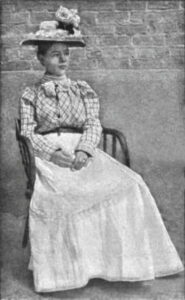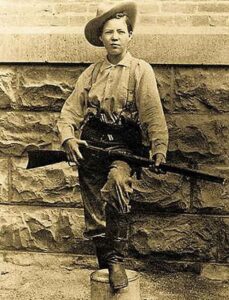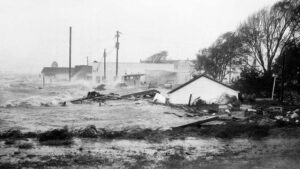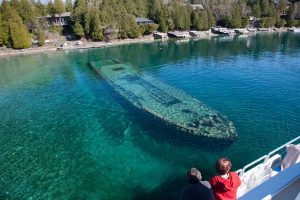ontario

 Pearl Hart was born Pearl Taylor in 1871, in the Canadian village of Lindsay, Ontario. Her parents were both religious and affluent, which allowed them to provide their daughter with the best available education. At the age of 16 and a bit of a rebel, she was enrolled in a boarding school where she fell in love with a young man named Hart, who has been variously described as “a rake, drunkard, and/or gambler.” That reputation didn’t deter Pearl and before long, the couple eloped, but Pearl soon discovered that her new husband was abusive and left him to return to her mother.
Pearl Hart was born Pearl Taylor in 1871, in the Canadian village of Lindsay, Ontario. Her parents were both religious and affluent, which allowed them to provide their daughter with the best available education. At the age of 16 and a bit of a rebel, she was enrolled in a boarding school where she fell in love with a young man named Hart, who has been variously described as “a rake, drunkard, and/or gambler.” That reputation didn’t deter Pearl and before long, the couple eloped, but Pearl soon discovered that her new husband was abusive and left him to return to her mother.
One would have thought that she would have learned her lesson and changed her ways before her future life of crime got started, but she chose to become an American Old West outlaw. Pearl Hart gained notoriety just before the turn of the 20th century as a female stagecoach robber. She cut her hair short, dressed in men’s clothing. She actually committed one of the last recorded stagecoach robberies in the United States, and her crime gained notoriety primarily because of her gender. To find out that a woman of that era was brave enough to pull off a stagecoach robbery was very unusual indeed.
Many details of Hart’s life are uncertain, with available reports being varied and often contradictory. It is thoughts that Hart reconciled with and left her husband several times. During their time together they had two children, a boy and a girl, whom Hart sent to her mother who was then living in Ohio. At least her children had a stable home. In 1893, the couple attended the Chicago World’s Fair, where he worked for a time as a midway barker. She in turn developed a fascination with the cowboy lifestyle while watching Buffalo Bill’s Wild West Show. At the end of the World’s Fair, Hart left her husband again on a train bound for Trinidad, Colorado, possibly in the company of a piano player named Dan Bandman.
By early 1898, Hart was in the town of Mammoth, Arizona. Some reports indicate she was working as a cook in a boardinghouse, while others indicate she was operating a tent brothel near the local mine. While doing well for a time, her financial outlook took a downturn after the mine closed. About this time Hart attested to receiving a message asking her to return home to her seriously ill mother. Looking to raise money, Hart and a friend known only as “Joe Boot” worked an old mining claim he owned, but they found no gold in the claim.
It was then that they decided to rob the stagecoach traveling between Globe and Florence, Arizona. On May 30, 1899, at a watering point near Cane Springs Canyon, about 30 miles southeast of Globe, they began their robbery run. Hart had cut her hair short and dressed in men’s clothing. Hart was armed with a .38 revolver while Boot had a Colt .45 revolver. The stagecoach run had not been robbed in several years, so the coach did not have a shotgun messenger. The pair stopped the coach and Boot held a gun on the robbery victims while Hart took $431.20, which would be about $13,500 today, and two firearms from the passengers. After returning $1 to each passenger, she then took the driver’s revolver. It was such an odd gesture. After the robbers made their getaway, the driver unhitched one of the horses, headed to town to alert the sheriff.
Accounts of the next few days vary. According to Hart, the pair took a circuitous route designed to lose anyone who followed while they made their future plans. Others claim the pair became lost and wandered in circles. Regardless, a posse led by Sheriff Truman of Pinal County caught up with the pair on June 5, 1899. Finding both of them asleep, Sheriff Truman reported that Boot surrendered quietly while Hart fought to avoid capture. Hart was eventually caught and after being found guilty, sentenced to five years in prison. She was pardoned 
 after three years. Some accounts have her returning to Tucson 25 years after her imprisonment to visit the jail cell that once held her. A census taker in 1940 claimed to have discovered Hart living in Arizona under a different name, as she had married again. Pearl Bywater was living a private life with her husband of 50 years, George Calvin “Cal” Bywater. She is acknowledged as the only known female stagecoach robber in Arizona’s history, earning her the nicknames of “Bandit Queen” or “Lady Bandit.”
after three years. Some accounts have her returning to Tucson 25 years after her imprisonment to visit the jail cell that once held her. A census taker in 1940 claimed to have discovered Hart living in Arizona under a different name, as she had married again. Pearl Bywater was living a private life with her husband of 50 years, George Calvin “Cal” Bywater. She is acknowledged as the only known female stagecoach robber in Arizona’s history, earning her the nicknames of “Bandit Queen” or “Lady Bandit.”

 When I think of a hurricane, I think of a tropical storm that escalates, and I suppose most of the time, that would be right, but it isn’t always the case. Sometimes hurricanes can develop in a more northern area, or as in the case of Hurricane Hazel on October 15, 1954 a strong hurricane somehow continues north as a hurricane after it hit first in a more southern area. Hurricane Hazel was a hurricane that struck the Carolina’s, and then and then moved into Ontario as a powerful extratropical storm…still of hurricane intensity, after that initial strike in the Carolinas.
When I think of a hurricane, I think of a tropical storm that escalates, and I suppose most of the time, that would be right, but it isn’t always the case. Sometimes hurricanes can develop in a more northern area, or as in the case of Hurricane Hazel on October 15, 1954 a strong hurricane somehow continues north as a hurricane after it hit first in a more southern area. Hurricane Hazel was a hurricane that struck the Carolina’s, and then and then moved into Ontario as a powerful extratropical storm…still of hurricane intensity, after that initial strike in the Carolinas.
The deadliest hurricane of the 1954 Atlantic hurricane season, Hurricane Hazel was also the second costliest, and the most intense hurricane of that year. The storm killed at least 469 people in Haiti before striking the United States as a Category 4 hurricane near the border between North and South Carolina. As Hazel ripped through Haiti, it destroyed 40% of the coffee trees and 50% of the cacao crop, which would drastically affected the economy for several years.
After causing 95 fatalities in the US, Hazel struck Canada as an extratropical storm, raising the death toll by 81 people, mostly in Toronto. When Hazel made landfall near Calabash, North Carolina, it destroyed most waterfront homes. Then as it screamed north along the Atlantic coast, Hazel affected Virginia, Washington DC, West Virginia, Maryland, Delaware, New Jersey, Pennsylvania, and New York; as it lashed the area with gusts near 100 miles per hour and caused $281 million, which today would be $2720 million in damage. When it was over Pennsylvania, Hazel consolidated with a cold front and turned northwest towards Canada.
In addition to the fatalities, Hurricane Hazel brought with it flash flooding in Canada, which destroyed twenty bridges, killed 81 people, and left over 2,000 families homeless in Canada alone. In all, and including the strike in the Carolinas, where Hazel killed 95 people and caused almost $630 million ($6,100 million today) in damages, on top of over 500 other deaths and billions in damage in the US and Caribbean. No other recent natural disaster on Canadian soil has been so deadly. Floods killed 35 people on a single street in Toronto.
When it hit Ontario as an extratropical storm, rivers and streams in and around Toronto overflowed their banks, which caused severe flooding. As a result, many residential areas in the local floodplains, such as the Raymore Drive area, were subsequently converted to parkland. In Canada alone, over C$135 million (C$1.3 billion, 2021) of damage was incurred. The effects of Hazel were particularly unprecedented in Toronto due to a combination of heavy rainfall during the preceding weeks, a lack of experience in dealing with tropical storms, 
 and the storm’s unexpected retention of power despite traveling 680 miles over land. The storm stalled over the Toronto area, and although it was now extratropical, it remained as powerful as a category 1 hurricane. To help with the cleanup, 800 members of the military were called in and a Hurricane Relief Fund was quickly established that distributed $5.1 million ($49.1 million today) in aid. The name Hazel was retired as a named storm, because of the high death toll.
and the storm’s unexpected retention of power despite traveling 680 miles over land. The storm stalled over the Toronto area, and although it was now extratropical, it remained as powerful as a category 1 hurricane. To help with the cleanup, 800 members of the military were called in and a Hurricane Relief Fund was quickly established that distributed $5.1 million ($49.1 million today) in aid. The name Hazel was retired as a named storm, because of the high death toll.
 On August 23, 1885, the schooner, Sweepstakes hit a rock near Cove Island on the Canadian side of Lake Huron, and sank in shallow water close to the light station. There she remained until transport could be arranged. Sweepstakes was built in Burlington, Ontario in 1867, by Melancthon Simpson. The wooden schooner’s had two masts, and sported a length 119 feet. The hull’s maximum depth was 20 feet. The schooner weighed approximately 218 tons. Sweepstakes was last owned by George Stewart, who lived in Mooretown, Ontario. Because she ran aground on a rock, her crew were able to escape, so her sinking took with it only one casualty…Sweepstakes, herself. She rests in the Fathom Five National Marine Park.
On August 23, 1885, the schooner, Sweepstakes hit a rock near Cove Island on the Canadian side of Lake Huron, and sank in shallow water close to the light station. There she remained until transport could be arranged. Sweepstakes was built in Burlington, Ontario in 1867, by Melancthon Simpson. The wooden schooner’s had two masts, and sported a length 119 feet. The hull’s maximum depth was 20 feet. The schooner weighed approximately 218 tons. Sweepstakes was last owned by George Stewart, who lived in Mooretown, Ontario. Because she ran aground on a rock, her crew were able to escape, so her sinking took with it only one casualty…Sweepstakes, herself. She rests in the Fathom Five National Marine Park.

On September 3rd the tug Jessie towed Sweepstakes into Big Tub Harbor so she could be repaired, but it was found that the Sweepstakes was beyond repair. So, the repair soon became a salvage of sorts. She was stripped of all useful rigging and equipment. The she sank in her present location in Tub Harbor, at Tobermory, Ontario, Canada. At the time of her sinking, Sweepstakes was still fully loaded with coal. Her cargo was salvaged at a later date. It seems a sad end to the little ship that was majestic in her time, but it isn’t really the end for her.
The area where Sweepstakes now lies is a fairly shallow spot, so she is visible to people on small boats passing  nearby. Her hull is almost completely intact, and she rests in about 20 feet of very clear water at the head of Big Tub Harbor. Two mooring buoys mark her location as a warning to unsuspecting boaters. Although deteriorating a little more each year, the Sweepstakes is one of the best preserved nineteenth-century Great Lakes schooners to be found. Nearby, the wreck of The City Of Grand Rapids rests. Both wrecks are visited frequently by glass-bottom tour boats. During the spring and fall, the site is shared by both divers and boats. Even just looking at pictures of the boats is interesting. It’s almost strange to think you can see a shipwreck from the top of the water.
nearby. Her hull is almost completely intact, and she rests in about 20 feet of very clear water at the head of Big Tub Harbor. Two mooring buoys mark her location as a warning to unsuspecting boaters. Although deteriorating a little more each year, the Sweepstakes is one of the best preserved nineteenth-century Great Lakes schooners to be found. Nearby, the wreck of The City Of Grand Rapids rests. Both wrecks are visited frequently by glass-bottom tour boats. During the spring and fall, the site is shared by both divers and boats. Even just looking at pictures of the boats is interesting. It’s almost strange to think you can see a shipwreck from the top of the water.

